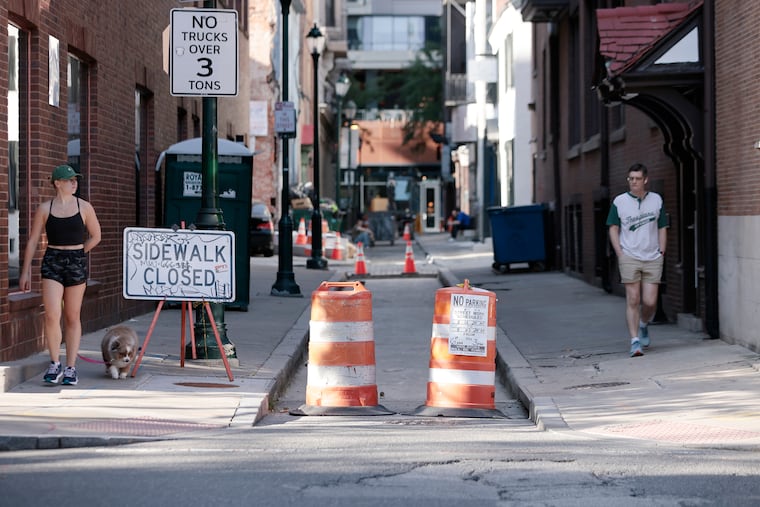Camac Street will once again be Philly’s only wooden street
"The Little Street of Clubs," as the historic Midtown Village thoroughfare is known, had been paved over with asphalt in 2015. Soon, the quirky wood will return.

For the better part of a century, the allure of tiny Camac Street — or at least the two-block stretch of it in Center City — was its curious paving, or lack thereof.
The side street packed with literary clubs, bars, and artists’ collectives was the last wooden street in Philadelphia, and one of only a few anywhere in the country — a charming relic of an abandoned experiment from the turn of the 20th century.
But in 2015, after several botched attempts to restore the rotting blocks, the wood was torn up in favor of asphalt, and Camac’s pavers became a throwaway line in neighborhood tour guides’ patter.
Now, the quirky wood paving is set to return.
As part of a long-delayed project to restore a trio of historic Philly streets, the narrow thoroughfare between Walnut and Locust, long known as “The Little Street of Clubs,” will be returned to its wooden roots. Work began last month, and the city hopes to restore the street by the end of the year.
The effort is being cheered by preservation advocates, historians, and residents, who have long pined for Camac’s removed wood. For them, the splintered pavers were more than just an eye-catching curiosity, but a window into the story of the city.
‘Philadelphia’s Greenwich Village’
“It’s always been a little haven,” said Bob Skiba, a tour guide and curator of the archive at the William Way LGBT Community Center, who has long been drawn to Camac’s distinct character.
The street first appeared on city maps in 1813, he said. Back then, Camac was known as Hazel Alley, and later Dean Street, before eventually being named after Turner Camac, a wealthy Irish sea captain who had settled in Philadelphia. By the late 1890s, Camac had become an enclave for working-class white and Black residents, who lived side by side in small, two-story homes.
“Camac Street was not an upper-class area,” Skiba said.
By the turn of the last century, Camac Street hummed with new life. Billing itself as “The Athens of America,” Philly burst with clubs dedicated to everything from arts to science to fine dining. These private membership organizations, often divided by class, race, and sex, sprang up in every corner of the city. Camac Street, hidden away in the heart of downtown, became a destination.
In 1902, the Sketch Club, now the oldest private artists’ club in the country, opened its doors on Camac. It was followed by the Franklin Inn Club, a still-thriving meeting spot for writers, and the Plastic Club, Philly’s oldest women’s arts organization. Bohemians, artists, and outcasts packed Camac’s cafes, speakeasies, and street fairs. Gay bars and businesses flourished, tucked away on Camac.
“This little tiny strip right in downtown Philadelphia was calling itself ‘Philadelphia’s Greenwich Village,’” Skiba said.
While tiny Camac reveled in its reinvention, the growing city beyond it yearned to become something else: quieter. The city officials thought wood streets were the answer.
In 1838, trying to drown out the rising din of trolleys and carriages clanging along the cobblestones, the city had repaved a stretch of Chestnut Street with wood. But the new streets floated away during the first torrential rains.
“It was before anybody had learned to make pre-hardened wood,” Skiba explained.
The wooden streets that didn’t wash away may have been quieter, but they soon took on a distinct odor, said Paul Steinke, executive director of the Preservation Alliance for Greater Philadelphia.
“They soaked up all the horse urine and became redolent in a bad way,” he said.
By the 1910s, when the city replaced countless colonial-era streets, including Camac, with wooden pavers, they knew to use sturdier blocks, but now it was their timing that stunk. With the arrival of the automobile just years later, Philly’s wooden streets quickly went the way of asphalt.
A series of failed restorations
All except Camac. It lasted until it didn’t.
City workers first attempted to restore the street’s aging blocks in 1977. The new ones they installed quickly disintegrated. In 1997, officials promised newly restored wood would last for decades. It didn’t. After another restoration effort in 2008, drainage issues rotted the wood away.
Water would pool in the street and freeze and crack, and rot the wood from the bottom, Skiba said.
The city didn’t bother with new wood while tidying up the city for Pope Francis’ visit in 2015. Instead, city workers paved over Camac with asphalt. And despite a steady drumbeat of advocacy from groups like the Preservation Alliance to put the wood back, it stayed that way.
Matt Cassidy, a spokesperson for the city’s Department of Streets, said that the city had always planned to restore Camac, but was slowed by the pandemic. Funded by a $1 million state grant, the city’s Historic Streets Project will also restore historic paving along East Mermaid Lane in Chestnut Hill and Waverly Street near 15th Street in Center City, he said.
After so many failed tries on Camac, planners are proceeding with caution. This time around, the street is being rebuilt to its historic wood-block design, with improvements to allow for better drainage, Cassidy said. Designers chose black locust wood for its natural resistance to rot, he said.
For Camac boosters like Skiba, the work can’t be finished soon enough.
“A little piece of history is being restored,” he said.